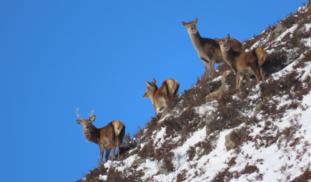Please wait...
About This Project
Increased recreational activity can lead to disturbance of wildlife, like red deer, with environment (direct, indirect), welfare, and economic consequences. My research will quantify red deer responses to hillwalker activity by recording distribution, behaviour, and assessing population trends. I aim to collar deer to gain fine-scale information on individuals, support existing datasets, provide data unique to this region and species, and to inform conservation management decisions.
More Lab Notes From This Project

Browse Other Projects on Experiment
Related Projects
How do polar bears stay healthy on the world's worst diet?
Polar bears survive almost entirely on seal fat. Yet unlike humans who eat high-fat diets, polar bears never...
Uncovering hidden insect diversity associated with a likely undescribed gall-forming midge
Does a likely undescribed species of gall-forming midge (pers. comm. Ray Gagné) on Eriodictyon plants (Yerba...
Macrofungi of the California archipelago
The eight islands of the California Archipelago are a well-studied biodiversity hotspot — but we know almost...


